Ya-Lun Lai, Fu-Yuan Li
Tatung University, The Graduate Institute of Design Science, Taipei, Taiwan
Correspondence to: Ya-Lun Lai, Tatung University, The Graduate Institute of Design Science, Taipei, Taiwan.
| Email: |  |
Copyright © 2016 Scientific & Academic Publishing. All Rights Reserved.
This work is licensed under the Creative Commons Attribution International License (CC BY).
http://creativecommons.org/licenses/by/4.0/

Abstract
Taiwan is a nation that inherits Chinese orthodoxy where people of talent emerge in succession. In order to carry forward Taiwanese religious tradition, this study analyzed Taiwanese ritual and Din Tao culture in depth and has found that in Din Tao culture, Taiwanese Lion is one of the activities which best represents Taiwanese. Thanks to its connotation of good fortune, abundance, and protection of the local, people's affection of Taiwanese Lion continues up to now. This study adopted literature review, field surveys, an expert of Taiwanese Lion to understand the development of Taiwanese Lion in order to establish design specification for cultural and creative products through the discussion with experts, complete the demonstration design of Cloud Lion Rocking Chair, and offer a model of the conversion of Taiwanese cultural elements to the design of cultural and creative products.
Keywords:
Taiwanese Lion, Cultural and creative design, Rocking chair
Cite this paper: Ya-Lun Lai, Fu-Yuan Li, A Study of the Conversion of Taiwanese Cultural Elements to the Design of Cultural and Creative Products - A Case Study of “Taiwanese Lion”, International Journal of Arts, Vol. 6 No. 1, 2016, pp. 11-20. doi: 10.5923/j.arts.20160601.02.
1. Research Motives and Purposes
1.1. Research Motives
The study has found that in the heritage in various places in Taiwan, "Taiwanese Lion" is one of the activities which best represents people's livelihood. It can be found in temple ceremonies, the completion ceremony of a new house, wedding, and funeral. In order to make people in modern times aware of its symbolic meaning, this study particularly analyzed the cultural elements of "Taiwanese Lion" to reflect the sanctity of Taiwanese religious culture. Moreover, through the design of sample products, this study raise the public's awareness of the value of local and traditional arts and the specific methods of cultural and creative design via "Cloud Lion".
1.2. Research Purposes
This template, created in MS Word 2003 and saved as “Word 2003 – doc” for the PC, provides authors with most of the formatting specifications needed for preparing electronic versions of their papers. All standard paper components have been specified for three reasons: 1) ease of use when formatting individual papers, 2) automatic compliance to electronic requirements that facilitate the concurrent or later production of electronic products, and 3) Margins, column widths, line spacing, and type styles are built-in; examples of the type styles are provided throughout this document. Some components, such as multi-leveled equations, graphics, and tables are not prescribed, although the various table text styles are provided. The formatter will need to create these components, incorporating the applicable criteria that follow. Use the styles, fonts and point sizes as defined in this template, but do not change or redefine them in any way as this will lead to unpredictable results. You will not need to remember shortcut keys. Just a mouse-click at one of the menu options will give you the style that you want.This study covers the following purposes:1. This study aimed to evoke people's memory of Taiwanese Lion and their concern over traditional and liberal arts. 2. It analyzed the cultural symbols of the head of "Taiwanese Lion" and converted them into available design elements to establish design specifications by experts and integrate cultural thinking. 3. It expanded the opportunities and space for craftsmen through the cooperation between craftsmen and designers. 4. The sample design in this study did not focus on modeling merely but started from metaphysics, combined the thinking of traditional process, created modern products, and bring about new existing significance to old culture.5. It combined the techniques of Taiwanese traditional craft and utilized composite media to design more diversified works.
2. Literature Review
During literature review, this study has found that "Taiwanese Lion" was introduced in China along with Buddhism, which later became closely related to the life of the immigrants to Taiwan. Hence, sections below will interpret the spirit significance and artistic achievement of Taiwanese Lion.
2.1. The History of "Taiwanese Lion"
"Taiwanese Lion" can be traced back to China, which developed in Taiwan. However, there is no clear record of lion dance in China. And the records of the time of lion dance were different. "Lion Dance Techniques" written by Tseng read that, "Lion does not originate from China but India and some other places. It was introduced into China along with Buddhist culture." The Buddhist scriptures introduced from India to China referred to Buddha as lion. Mahaprajnaparamita Upadesha had mentioned that, "Buddha is the lion among human." Fo Shuo Tai Zi Rui Ying Ben Qi Jing (literally, dialogues between a Buddha and a prince) wrote that, "When the Buddha was born, five hundred lions came down from snow-capped mountains and guarded at the door sides." The proofs of the introduction of lion along with Buddhism included: (1) read, "There are eighteen deities who protect Garan," wherein the eighth is a lion. (2) Records of Vimalakirti (Li Gongquan in the Song Dynasty) read, "A ferocious lion sits beside Manjushri (as his mount) with fierce face, exposed teeth, thick mane, large palms and long claws." Hui-lin, a famous monk in the Tang Dynasty wrote in The Sound and Meaning of the Tripitaka that, "Suanni (one of the sons of the Dragon King) is a lion who comes out from the West." It can be seen from the above classic Buddhist literature that lion originated from the West and was introduced to China via the tributes to Chinese emperors and the spread of Buddhism. It has a supreme symbol of wisdom and nobility in Buddhism and thus has a far-reaching impact on the Chinese nation.  | Figure 1. A Statue of Manjushri and his lion at Dunhuang Mogao Grottoes |
2.2. The Development of "Taiwanese Lion" in Taiwan
Chinese and Taiwanese traditions have always believed that a lion can drive out evil spirits, bring about brightness, fortune, and blessing. Therefore, in the earlier buildings in Taiwan, the patterns of lion could be found on daily necessities, clothing, furniture, stationery, and so on. Besides, sky, the earth, the sun, the moon, stars, giant plants and animals worshipped by people in ancient times were often deified. In Taiwan, on the mention of a lion, one must not ignore the existence and value of Lion Group. Tseng pointed out in Planning Report on Taiwanese Traditional Folk Arts that, "The establishment of Taiwan Lion Dance Group at first aimed to defend foreign aggression, bullying, and harassment by robbers. It was like a local defense organization. Its members practiced martial arts, protected villages, and performed during celebration. Hence, lion dance became very popular. During the exploration of Taiwanese history, this study has found that Taiwan was an island harassed by pirates. Though the Han came here in the Ming Dynasty, they were mostly immigrants or exiled criminals. When there were a few people in the island, it was dangerous. People here lived a hard life. It can be concluded that lion dance is closely related to the cultivation of Taiwan by the ancestors. However, Taiwan had always been colonized. After the demise of the Ming Dynasty, Zheng Chenggong regarded Taiwan as the revival base of "rebelling Qing dynasty and rebuilding Ming dynasty". The activity of lion dance had started to develop at that time. The increase of population later on enhanced the development of lion dance in Taiwan. The literature which clearly recorded the time of Taiwanese lion dance was Taiwan Government Records written by Kao in 1694 which mentioned that, "From New Year's Day to the 15th of the first lunar month, youngsters wore the customs of crane, lion, and horse to dance with the rhythm of drum." Many literature later had the same record such as Record of Zhuluo County, Annals of Taiwan, and New Taiwan Government Records. In addition, Lien wrote in Ya Yan (literally graceful language) in 1921 that, "On the 15th of the first lunar month, there was performance of dragons. People used bamboos to make dragons and colored their scales. Also there was performance of lions. Such performances were popular in villages." It can be concluded by the above literature review that Taiwanese have high respect to lion dance which represents the fear of the local towards evil spirits and their hope for blessing embedded in lions. Lion was regarded as one of the nine sons of the Dragon King to achieve its perfect status. During the performance of lion dance, young people were attracted which gradually formed the base of Lion Dance Group. The Group protected villages and the nation against danger and even supported the alliance of rebelling Qing dynasty and rebuilding Ming dynasty during the time of Zheng Chenggong. Due to the prosperity of Lion Dance Group and its combination with traditional temple fairs, lion dance becomes a unique way of celebration on the nights of the 15th of the first lunar month and inseparable and significant activity in Taiwanese ritual and opening ceremonies.
2.3. Exploration on the Head of "Taiwanese Lion"
Via the visits to and interviews with experts, this study has found that "Taiwanese Lion" is mostly affiliated to local self-defense force team of Taiwanese folk beliefs. The most common types of lion dance in Taiwanese ceremonies are depicted as follows.Table 1. The most common types of lion dance in Taiwanese
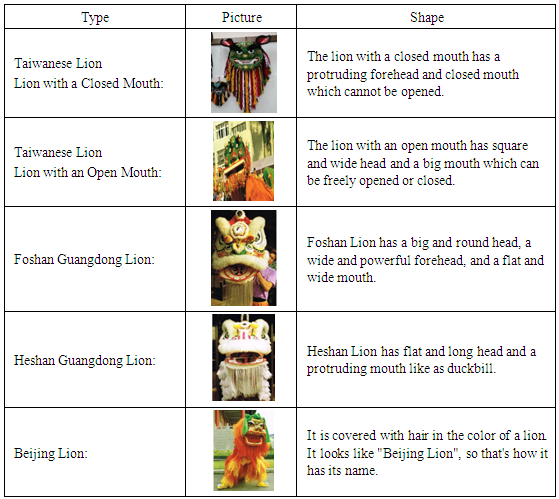 |
| |
|
This study has found that the colors and decorations of different types of lions vary with the climate, environment, and folk customs of different areas. "Taiwanese Lion" is mostly green. Taiwan is located in a warm southern region with dense trees, forests, and grasslands, so the green color has the significance of protection. The gorgeous appearance of Guangdong Lion is related to the flourishing harbor trade of Guangdong and Guangxi. Due to the active and booming economies in the two regions, local people are fond of magnificent appearance and manifestation. "Beijing lion" not only looks like a Pekinese. Its yellow hair covering its body is a symbol of the northern Loess Plateau.The preservation of the appearance of "Taiwanese Lion" not only stands for the religious culture, religious beliefs, and technology, but also inherits and records the living and culture of our ancestors. The understanding of the culture and pattern features and styles of "Taiwanese Lion" is helpful for the understanding of the history, culture, aesthetic value, and historical heritage represented by Taiwanese Lion.
2.4. Analysis of the Appearance Elements of "Taiwanese Lion"
From the above discussion of the types of lion head, we can see that cultures, habits, and appearances of lion heads are different by geography. In order to understand the significance of the appearance of Taiwanese Lion, this study conducted deep analysis on the Taiwanese Lion with a Closed Mouth. Guangdong Lion and Beijing Lion were introduced to Taiwan after the retreat of nationalist government, while the Taiwanese Lion with a Closed Mouth is a unique local lion appearance and the most common in lion dance in Taiwan. Thus, this study focused on the exploration of Taiwanese Lion.This study specially interviewed Mr. Shun-rong Shih, a master craftsman of "Taiwanese Lion" who assumed that, "The most basic feature of the head of Taiwanese Lion is big and round. The positions of eyes, nose, mouth, and ears are divided by an invisible cross. Taiwanese Lion emphasizes the distinction of "Three Mountains and Five Mountains". Three Mountains refer to forehead, nose, and jaw. Plus the two cheeks, they become Five Mountains. They must be upright. "Three Mountains and Five Mountains" adopted the concept of Meridian and parallel to make the organs appear in appropriate portions and positions. The mouth looks like a shoe-shaped gold ingot. The face of Taiwanese Lion shall contain the Five Elements which are shown by the five colors, white, green, black, red, and yellow. It is difficult to produce the facial expression of Taiwanese Lion as it differs by the personalities of its creator. | Figure 2. The appearance of Taiwanese Lion |
Mr. Shih emphasized that the process of producing a lion head could make one understand the truth of Face comes from heart because the facial expression of the lion is closely related to the emotion of its creator. The majesty, solemnity, strength, and flexibility of a lion head show the heart and mind of its creator. Therefore, the lion heads made in various places in Taiwan and by different craftsmen produced are different, which exhibits the richness of Taiwanese Lion.
3. Research Method and Procedures
3.1. Field Surveys
As of the classification of the features of "Taiwanese Lion", this study summarized the design content of "Taiwanese Lion" via interviews. Due to the regional difference, lion head in Taiwan shows difference in culture, habits, and forms. In order to understand the significance of the appearance of Taiwanese Lion, this study centered on the Taiwanese Lion with a Closed Mouth. Guangdong Lion and Beijing Lion were introduced to Taiwan after the retreat of nationalist government, while the Taiwanese Lion with a Closed Mouth is a unique local lion appearance and the most common lion in the public’s life. Thus, this study focused on the exploration of Taiwanese Lion. | Figure 3. An interview with Mr. Shun-rong Shih, a master of Taiwanese Lion and his representative work |
This study focused on and summarized the oral explanation by Mr. Shun-rong Shih (Figure 4). The appearance, symbol, color, and connotation of Taiwanese Lion are described in the following table 2.Table 2. The appearance, symbol, color, and connotation of Taiwanese Lion are de-scribed in the following table
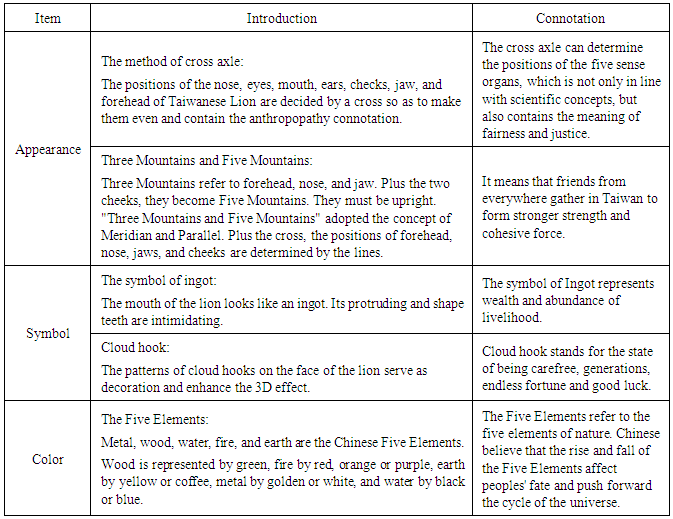 |
| |
|
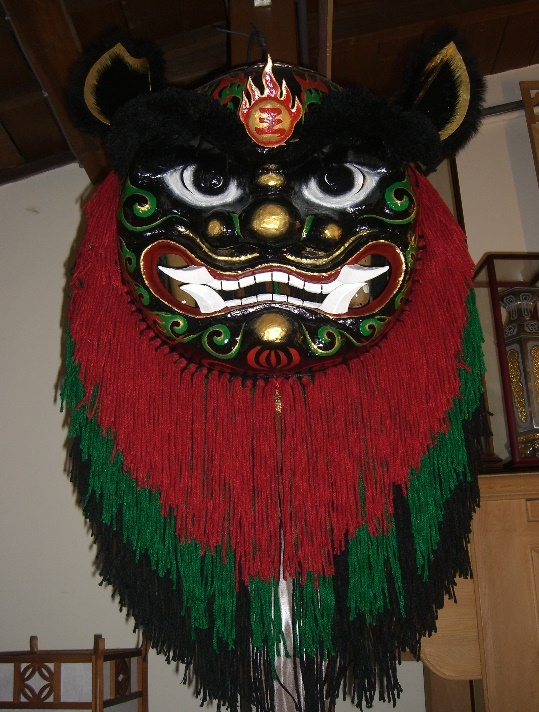 | Figure 4. A Taiwanese Lion head made by Mr. Shun-rong Shih, a master craftsman |
This study has found that the molding approach of "Taiwanese Lion" emphasizes the concepts of balance, symmetry, and totem. The paintings on its face imply the endless and natural balance standard of all things and the rules and norms of Taoism, Confucianism, and Buddhism. The facial pattern contains the meaning of round heaven and square earth. The face contains ten circles, while the whole face forms a big circle. The ten circles are reflected by the forehead, nose, wings of nose, cheeks, and jaws, with a meaning of the peak of perfection. Moreover, the overall pattern focuses on symmetry, which refers to rules and norms. "Taiwanese Lion" not only shows the divine beast introduced to China along with Buddhism, but also the strength of Taiwan ancestors who crossing the ocean and their flexibility and virtues to adapt to the environment. The elements in the painting and molding symbolizes the inheritance of the culture and spirit of Taiwan and the priceless treasure of process and technology, which is worth of exploring and discussing by designers, writers, artistic creators, and all circles.
3.2. Text Font of Entire Document
Via the interviews with experts, this study established the design specifications of "Cloud Lion Rocking Chair" with the efforts of the craftsmen of "Taiwanese Lion", designers of cultural and creative products through several discussions. The following seven specifications have been concluded:Design specifications:1. To apply the abstract patterns of lion to product design by the deconstruction of "Taiwanese Lion". 2. To utilize composite media to create new products during the conversion of cultural elements so as to echo the trend of modernization. 3. To apply one of the five colors for design by designers as the color elements for the connotation of the Five Elements are complex.4. To apply part of the features of the whole image of Taiwanese Lion. 5. To show the representative spirit and significance in a micro way of the facial expression of the lion face which is divided by the cross axle and Meridian and Parallel.6. To explicitly express the implicit spirit and symbol of "Taiwanese Lion" (protection of homeland, driving out evil spirits, and embracing blessing) in products.
4. The Methods and Theories of the Conversion of Cultural Image in Cultural and Creative Design
As of average design, a designer converts, modifies, and applies cultural elements based on his/her own cultural experiences and intuition. Through exploration and discussion, this study successfully obtained a creative expression during the process of design, which determines the diversification and integration of design conversion. During design, a designer explores cultural image and clarifies the availability, particularity, techniques and methods of conversion of design elements to enhance the condition and completeness of the application of cultural image in cultural and creative design. See below detailed explanation:Based on local cultural background, a designer explores social and cultural factors to understand the relationship among himself/herself, users, and products, which is lack of the research and exploration of the overall design and execution. Lin and Li believed that the way of manifestation of most current cultural and creative products to the public is the imitation of forms and reproduction and application of texture and color, which ignores the presentation of cultural image and connotation and has few benefit for the enhancement of living and culture by culture and creative design. He deemed that the material property, function, and structure of cultural and creative product design conveyed the cultural message of aesthetics, safety, taste, style, and so on, serve as the main medium for the communication between human and products, and reflect the lifestyle of the people of the region. Thus, the purpose of applying cultural image in cultural and creative products is to convey the overall image of regional culture and national characters. It can be seen that in the conversion of cultural and creative design, besides the basic approach based on experiences, the conversion of cultural image and element language expressed by design form the complete communication with users.Each country has distinct traditional culture and lifestyle. In the global market competition, the design application with cultural characteristics can enhance the uniqueness of products and consumer experience. A designer explores the representation of cultural image from the perspective of communication via design message, interprets the elements of cultural image in design, points out the key points and suggestions of the design of cultural and creative products, explores the maturity and completeness of product design, effectively establishes the connection between users and products, and designs products which touch consumers. From the above theory, this study, based on literature review, expert interviews, and field surveys, offers a summation of cultural element conditions and user common experiences corresponding to the empirical law. The method reinforces the concept of design and the intuitive mode of the function of appearance. However, during the conversion of cultural image, this study deemed that the gathering of cultural elements and the triggering of image can achieve the application in design. The three aspects can help a designer define the shape and appearance of a product which correspond to the spirit and connotation of cultural image but fail to form a specific conversion method. Therefore, this study put forward a method of "integration design of the conversion and application of cultural image". First, based on literature review and the interviews with experts, it conducted deep analysis on cultural elements, and developed application method, the mode and norm to covert cultural elements. Also, it emphasized the integration of design, the feedback of application, and the interpretation and summarization of cultural connotation to enhance it connotation. It sought new materials for study, development, application in design. It combined and extended traditional techniques and ways of expression and utilized new creation and traditional techniques, obtained multi-layer and multi-direction feedback mechanism and interpretation and summarization of cultural connotation so as to enrich the overall connotation of design. The new integrated design methods of the conversion and application of cultural image are described as follows:
4.1. The Integrated Design of the Conversion and Application of Cultural Image
This study explored the conversion and application of the elements of Taiwanese Lion in product design and developed integrated design methods to complete the design of "Cloud Lion Chair" which was shown at the exhibition of "All the Way East Design Alliance" at 2015 Taiwanese Designer Exhibition Week and received the praise and recognition from Taiwanese and foreign visitors. Based on the careful analysis of Figure 2 "The integrated design of the conversion and application of cultural image", the design architecture is classified into the process of cultural and creative development, integrated application and feedback of design, and the method of culture image design. As of the process of cultural and creative development, the historical origin of cultural relics had been proved through literature review. And the development of cultural relics had been understood through the interviews with experts. Through the deconstruction and analysis of the elements of cultural relics, design specifications had been set up. The integrated application and feedback of design had been summarized after the interpretation of cultural elements. This study probed into the development of new materials and the re-application combined with traditional techniques and processes. And modification had been done via the survey of products usage and the feedback from users.In the overall design pattern, this study focused on the method to analyze cultural elements and gathered available totem and design conditions via the abstraction of elements. In order to understand the metaphysical principle reflected by the elements during the conversion and application of the elements, the gathering of elements were conducted in separate steps. a. It explored the connotation of cultural elements and highlighted the spirit of metaphysics. b. It proved whether the specification of the elements conformed to the institutionalized spirit of behavioral model. Lastly, it returned to the explicit form study and defined the cultural characteristics, function, and significance represented by the elements. All the steps conformed to the method and rule of metaphysics to correspond to the internal spirit by the external appearance. Repeating affirmation can make design thinking more clearly so as to achieve more creative development and application. In addition, during the conversion of the elements of cultural image, this study proposed three methods for a designer when he/she contacts complex element forms: 1. To extract the partial features of cultural elements; 2. To apply in a micro way; 3. To directly apply the totem of elements. The three methods simplify the elements of culture image, extract parts of the elements for conversion, or exaggerate and apply elements in a micro way. Lastly, in average design model, elements can be regarded as totem element and used as decoration directly. This study, based on "the integrated design of the conversion and application of cultural image", collected complete and huge design elements, adopted literature review and interviews with experts, and took into consideration of the function of products and the demands of users so as to achieve overall design. | Figure 5. Integrated design of the conversion and application of culture image |
5. Demonstration Design
This study adopted the design specifications set up by experts and designers to carry out demonstration design. In order to give full play of the design specifications, this study cooperated with Don Jon Co., Ltd., a well-known furniture maker in Taiwan to develop a modern and fashionable rocking chair, i.e. "Cloud Lion". After its completion, the work had been invited to be shown at the professional exhibition of 2015 Taiwanese Designer Exhibition Week. The R&D, application of design specifications, methods, and process are described as follows:
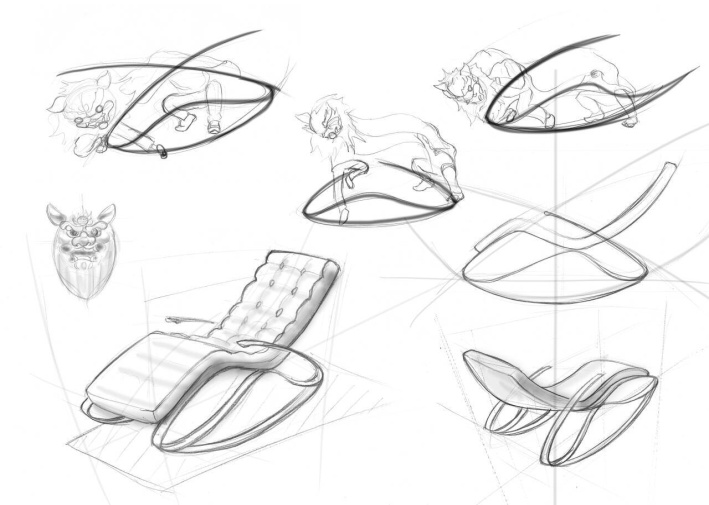 | Figure 6. Sketches about the development of concepts |
 | Figure 7. A view of "Cloud Lion" rocking chair at 45 degree angle |
5.1. The Design Concept of "Cloud Lion", a New Type of Rocking Chair in Taiwan
The design of "Cloud Lion" rocking chair attempts to break through tradition. In addition to the cooperative development with professional furniture manufacturer, the chair focuses on the radian in line with ergonomics and extreme simplified design, which was different from average rocking chairs. It combines traditional process, technology, and spirit. As of structural capacity, it combines smiling curve with massif-shaped radian to form interaction force and make the overall structural stress more stable and visual effects more balanced. Thus, when one sits or lies on it, he/she can have calm and peaceful state of mind.The design and production of the seat and back of "Cloud Lion" is of unibody structure covered by red leather and dotted by golden copper nails (lion-shaped buckle), which looks like the pattern of ancient palace gate. Its concept is derived from the decorative tassels on the back of Taiwanese Lion to imply the overall appearance of Taiwanese Lion. Its structure is an attempt of the abstraction of Taiwanese Lion appearance and implies the state of a sleeping lion so that users can experience the curved modeling of the chair.The lower part of the chair integrates traditional embroidery and has the patterns of sea tides embroidered with gold threads. When Taiwan Lion dances, the tassels in the colors of the Five Elements moves and forms the pattern like sea tides. In order to integrate the traditional technique and the specific patterns of the sea tides in the design of "Cloud Lion" chair, the design had specially adopted professional electric embroidery technique with gold threads to present the refined style of traditional processes. The different parts of the chair echo with each other and integrate complete overall design in line with the design specifications and spirits of the experts. The practical design of Cloud Lion chair shows the style and unique design of cultural creativity. | Figure 8. Front view of “Cloud Lion” rocking chair |
 | Figure 9. The professional exhibition of “Cloud Lion” rocking chair at 2015 Taiwanese Designer Exhibition Week |
The framework of the chair is welded by stainless steel. Its surface is mainly covered with red leather. Especially, the lower part of the chair has the patterns of sea tides which look like the movement of the tassels when Taiwanese Lion is dancing. Such sea tide patterns are embroidered by gold threads to showing the gorgeous and noble characteristics.In the design of the rocking chair, the pattern of "Taiwan Lion" has been reduced to the size of a buckle. The lion-shaped buckles not only enhance the beauty of the chair, but also imply the connotation of vitality and blessing. The buckles are made by bronze with 3D delicate carving of lion head and mane. The smooth buckles will not scratch the leather or human skin. They serve for the functions of connection, fixation, decoration, and security of structure.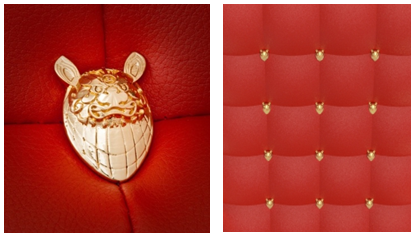 | Figure 10. Lion buckles of “Cloud Lion” rocking chair |
5.2. The Description of the Design Specifications by Experts
In the design and production of "Cloud Lion" rocking chair, this study, based on the design specifications set up by experts, combined stainless steel, feather, and other multiple media to break through the traditional process. The five key points of the design specifications are described as follows. 1. To deconstruct "Taiwanese Lion" and apply its abstract appearance to product design: As of the side view of the chair, in order to make users experience the grace of Taiwanese Lion, the design integrated the handle (A) and the smiling curve (B) into the big curve of the shape of mountains (C), resulting in stress balance. 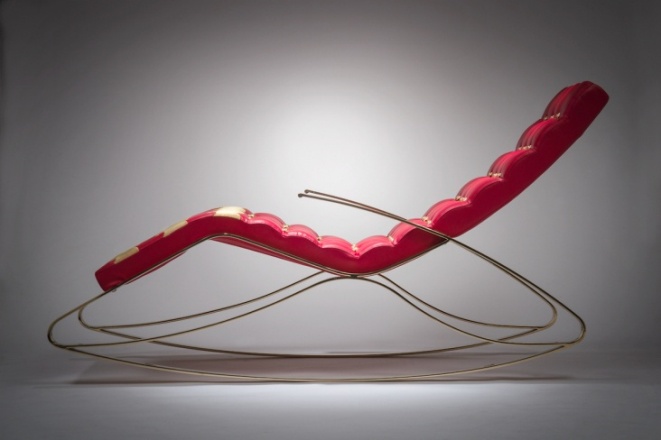 | Figure 11. The smiling curve and mountain curve of "Cloud Lion" Chair from its side view |
2. To echo the trend of modernization, in the conversion of cultural elements, we can make good use of composite media to create new products.The framework of "Cloud Lion" rocking chair is made of stainless steel, combined with breathable leather and elastic sponge so that reflect the stable and warm feelings. The golden embroidery on the red leather makes it more gorgeous. Lastly, lion buckles make the finishing point.3. The elements of Taiwanese Lion are complex as they combine the connotation and colors of the Five Elements. A designer and pick a single color for design. The Five Elements are metal, wood, water, fire, and earth. This study mainly adopted golden and red colors which stand for metal and fire respectively. Also, metal stands for autumn, a harvest and happy season, while fire stands for summer, a thriving season and has the meaning of being influential. This study reflected the internal expectation and vision through the external colors of golden and red. 4. "Taiwanese Lion" symbolizes the guardian of homeland, driving out evil spirits, and embracing good fortune. We can make its implicit spirit explicit and present it in product patterns. The framework of "Cloud Lion" rocking chair is made of golden titanize stainless steel to highlight its nobility. The red leather and golden embroidery imply the patterns on the back of Taiwanese Lion. Meanwhile, the overall appearance of the chair presents the model like a Chinese character, 井 (literally, a well) and looks like the bronze gate of ancient government office. The lion buckles are like the door rings which serve as the function of protection, driving out evil spirits, and embracing blessing.
6. Conclusions
This study investigated Taiwanese Lion and completed a design plan through the conversion and application of cultural image. The work had been exhibited at 2015 Taiwanese Designer Exhibition Week, received many feedbacks, and provoked introspection through the communication and exchange with over 100,000 people. The experiences and design behavior obtained from the design are summarized as follows:1. To take advantage of the abstract elements and apply them to product design:During the design of "Cloud Lion" chair, this study has found that the totem and appearance of Taiwanese Lions are diverse, so it is not easy for a designer to extract models. Thus, this study suggests that when one looks for totem and cultural image, he/she deconstruct the subject before design and conversion so as to reduce the complication of elements and achieve better design application through simplified approach.2. To inherit traditional Taiwanese culture and technology:This study had interviewed Mr. Shun-rong Shih, a master of Taiwanese Lion in Lukang, for several times. He explained that the craftsmen who made Taiwanese Lion got on in years, but young people in modern time could not appreciate the traditional culture due to the complex techniques, low income, and the changes of the times. Therefore, the evolution of Taiwanese Lion faces the dilemma of inheritance. This study actively explored the culture of Taiwanese Lion in order to provoke Taiwanese memory and make them willing to learn and innovate, and shoulder the responsibility of inheritance.3. The contemporaneity and diversity of the integrated design of the conversion and application of cultural image:The integration of the design thinking can make a designer carry out cultural and creative design more smoothly and extract partial features of cultural relics through the diverse conversion of image elements (top, middle, and down of metaphysics). Micro application and direction application of totem make the extraction and conversion of cultural image elements more flexible and respond directly to the functions of products. Such innovative mode has been proved by this study for years. It will not change along with the changes of the times or mainstream ideology. Instead, it will add diverse conditions and provoke infinite and creative design mechanism. 4. Inner feelings and spiritual significance of design:The research method of this study is helpful for a design to apply it in the thinking of product appearance. The designer still needs to conduct literature review, understand and analyze deeply the spirits of top, middle, and down of metaphysics. The internal connotation of culture depends on the feelings of the design on objects and how he can express such feelings through materials, colors, and modeling and complete professional design. Moreover, the outcome shall make its users recall or experience the value and connotation of cultural elements. Therefore, the cultivation of the ability of penetration is an essential and spiritual element for a designer.
References
| [1] | Chuang, P.H. (1994), Taiwanese Folk Arts Modeling, Taipei City: Artist Publishing. |
| [2] | Kao, K.C. (1694). Taiwan Government Record. A supplemented edition to the records by Chiang Yuying, the first magistrate of Taiwan. |
| [3] | Liu, C.W. (1991). Cultural Anthropology. Taipei: Artist Publishing. |
| [4] | Lin, R.T. (2009). A Study of Integrating Culture and Aesthetics to Promote Cultural and Creative Industries. Journal of National Taiwan College of Arts, 85, 81-105. |
| [5] | Lin, R.T. (2010). Cultural Innovation of Process Thinking. He, Y.H. and Lin, M.C. (Eds.), Cultural Innovation MIT-Fashionable New Taiwan (pp.118-124). Nantou: National Taiwan Craft Research and Development Institute. |
| [6] | Lu, H.W. (2009). New Bearings of Process Design — Transformation and Positioning of Process Industry. National Taiwan Craft Research and Development Institute (Ed.), Vision-2008 Taiwanese Creative Craft Industry (pp.104-111). Nantou: National Taiwan Craft Research and Development Institute. |
| [7] | Tseng, C.K. (1997). The Techniques of Lion Dance, Taipei City: Shu Chuan Publishing. |
| [8] | Tseng, C.K. (1997). Lion Dance Techniques (3). Taipei City: Shu Chuan Publishing. |
| [9] | Tuan, A.C. (888~894). The Department of Music in Tang Dynasty, Music, Dance, and Anecdotes of Actors. |
| [10] | Wang, H.L. (2003). The Evolution of Lion Dance in China, Traditional Arts No.37. |
| [11] | Wu, T.D. (1998), Taiwanese Folk Arts, Taipei County: Han Kuang Culture. |
| [12] | Wu, T.D. (2002), Taiwanese Folk Arts Tin Dao, Taichung City: Morningstar Publishing. |
| [13] | Wu, T.D. (2006). Research Report on the Survey of Golden Lion Tin Dao in Southern Taiwan. Taitung: Chinese Folk Arts Tin Dao Laboratory. |
| [14] | Yang, H.C. (the North Wei period). Garan of Luoyang, Vol. I, recording the Buddha statues and temples in Luoyang, commenting on politics and conditions of the people. |
| [15] | Yang, Y.F. (2006/2). The Cultural Foundation of the State: Design, Communication, and Symbol. Taipei: Asia-Pacific Publishing. |
| [16] | Yu, C.C. & Yeh, S.H. (1992). Symbol: Chinese and Art. Taipei: Chiu Ta Culture. |














 Abstract
Abstract Reference
Reference Full-Text PDF
Full-Text PDF Full-text HTML
Full-text HTML
